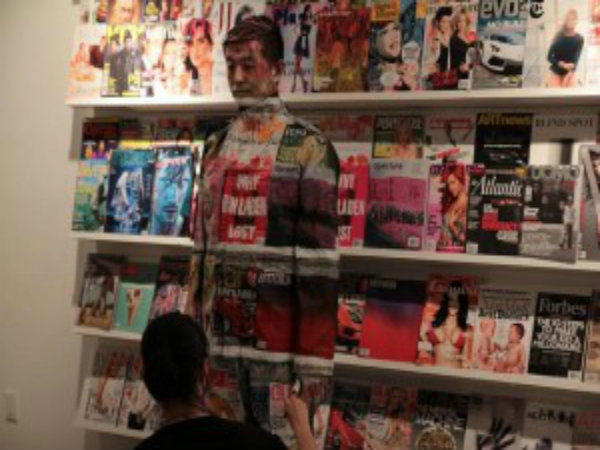Tilda Swinton is currently in the Museum of Modern Art (MoMA) in New York.
She is sleeping in a glass box.
Swinton appears spontaneously and unannounced in her exhibition entitled ‘The Maybe’. According to MoMA, she will be appearing six times over the course of the year in random locations throughout the museum.
This news has stirred the public into questioning, is this really art?
However, the answer to this is not easily resolved. Decade upon decade, art is redefined to the point where modern art now encompasses a sweeping scope of forms.
American artist and writer, Elbert Hubbard once said in his novel ‘Little journeys to the homes of great teachers’ : “Art is not a thing — it is a way.”
This sentiment resonates today more than ever.
Art has evolved and is no longer confined to a canvas. It instead has broken free into the realm of the audience.
Swinton’s ‘The Maybe’ performance is just one of the many new forms of art pushing the boundaries of what the industry is and how it is expressed.
Serbian performance artist and recent visitor to Australia, Marina Abramovic, is one of the leading pioneers of this modern art form. Heralded as ‘the grandmother of performance art’, one of her most well-known performances is ‘The Artist Is Present’, where she sits for 736 hours on a chair in MoMA, without eating, speaking or moving.
Abramovic spoke with Interview Magazine regarding how performance art compares with other art forms.
“Performance is such a strange thing because it’s so immaterial. We are talking about soft matter. We are talking about something that is invisible,” she says. “You can’t see it. You can’t touch it. You just can feel it.”
An Australian artist painfully committed to unconventional expressions of art is self-titled, Stelarc. His main performances include being hoisted into the air after having impaled himself on sixteen shark hooks and also having an ear sewed on to his arm as part of his ‘Ear on Arm’ project.
Although not all performance art, like Stelarc, is sadistic in nature. Liu Bolin, under his alias ‘Invisible Man’, paints himself to blend in with his surroundings, to the point where the audience cannot distinguish the artist from the background. He is most renowned for his ‘Hiding in the City’ series.
Earlier this year Brisbane’s Tina Havelock Steven performed her act entitled ‘Submerge’,as part of the MOFO festival organised by the Museum of Old and New Art (MONA) in Hobart. This involved the artist playing drums non-stop while she was lowered into the Derwent River.
Like Steven’s work, modern art is moving away from just being seen through the eyes but rather igniting all of the audience’s senses.
Sound art for example is pushing through the boundaries of traditional conceptions of art. It is not a form that can be seen but instead must be heard, further questioning how art is defined in terms of physical aesthetics.
Australian artist Robin Fox is renowned throughout the world for his sound pyramid called the ‘Giant Theramin’ – a musical innovation where passersby can create their own individual soundscape in reflection of how they interact with the pyramid. In this example the sound is acting as the art, instead of the object. The ‘Giant Theramin’ has been displayed internationally and was recently featured in Hobart and Melbourne.
Smells are also being seized in the name of art, again contradicting traditional material art constructions.
Artist Wim Delvoye’s work ‘Cloaca’ – a large installation currently held by MONA in Hobart – comes with realistic smells as food is mechanically processed into faeces.
As further abstract forms of art are explored, the boundaries of art itself are falling away. The emergence of a new art form, ‘non-visible art’, is questioning the guidelines around what is considered art.
‘Non-visible art’ is contradicting preconceived notions that art is a something that is experienced solely through the eyes and instead delves into the mind. This kind of art promotes a vision or an idea without form, taking the true sense of conceptual art to another level.
Actor James Franco and artist Praxis are currently supporting a project on Kickstarter to develop a Museum of Non-Visible Art. If acheived it will become a gallery of unfilled works of art, with descriptions of the envisioned artwork leaving the rest to be imagined by the audience.
One work entitled ‘Fresh Air’ has already been purchased by media producer Aimee Davidson for $10,000.
These new developments in art, whereby art is no longer a constructed piece but rather an imagined one, further blur the lines between the artist and the audience – raising the question of what is and isn’t art.
However, what is clear is that any traditional definitions are bound to be further questioned and contradicted as art evolves and inevitably becomes accepted for what it really is – indefinable.
 Tara Watson is a postgraduate journalism student at La Trobe University and is one of upstart’s staff writers. You can follow her on Twitter: @taraswatson
Tara Watson is a postgraduate journalism student at La Trobe University and is one of upstart’s staff writers. You can follow her on Twitter: @taraswatson
Featured Image: Flickr








